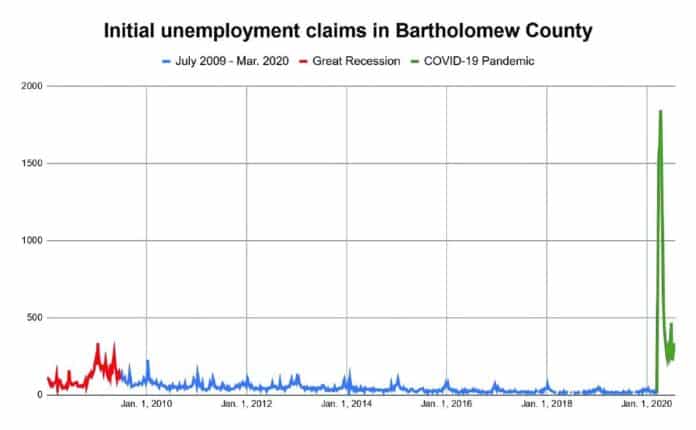More than 1 million laid-off Americans applied for jobless benefits for the 19th straight week in a sign of how weakened the job market remains during the COVID-19 pandemic.
More than 1.4 million laid-off Americans applied for unemployment benefits last week, The Associated Press reported. Before the coronavirus erupted in March, the number of Americans seeking unemployment checks had never exceeded 700,000 in any one week, even during the Great Recession.
In Indiana, 20,609 workers filed initial unemployment claims last week, up from 17,911 the previous week, the Labor Department said Thursday.
In Bartholomew County, 337 workers filed initial jobless claims the week ending July 25, the latest week on record, according to the Indiana Department of Workforce Development. That was up from 303 the week before, but still considerably less than the 1,845 claims filed the week ending April 11.
[sc:text-divider text-divider-title=”Story continues below gallery” ]
By comparison, Bartholomew County saw an average of around 41 initial claims per week between July 2009 and March 2020. Before the pandemic, the highest number of claims filed in a single week since January 2008 was 228 the week ending Jan. 9, 2010.
A total of 2,016 Bartholomew County residents were receiving unemployment benefits in Indiana as of July 18, down from 2,152 the week before and 5,039 the week ending May 2.
The new jobless data came as a grim picture emerged of a U.S. economy that has endured a record-shattering plunge last quarter and is now struggling to rebound as the coronavirus keeps forcing more layoffs, according to wire reports.
The economy shrank at a 32.9% annual rate in the April-June quarter — by far the worst quarterly plunge ever — when the viral outbreak shut down businesses, throwing tens of millions out of work and sending unemployment surging to nearly 15%.
The government’s estimate of the second-quarter fall in the gross domestic product was the sharpest such drop on records dating to 1947, according to wire reports. The previous worst quarterly contraction, a 10% drop, occurred in 1958 during the Eisenhower administration.
Most analysts expect the economy to produce a sharp bounce-back in the current July-September quarter, but with the rate of confirmed coronavirus cases having surged in a majority of states, more businesses being forced to pull back on re-openings and the Republican Senate proposing to scale back government aid to the unemployed, the economy could worsen in the months ahead, the The Associated Press reported.
An additional 830,000 million people applied for unemployment benefits under a new program that extends eligibility for the first time to self-employed and gig workers. All told, the government says roughly 30 million people are receiving some form of jobless aid, though that figure might be inflated by double-counting by some states.
The pain could soon intensify: A supplemental $600 in weekly federal unemployment benefits is expiring, and Congress is squabbling about extending the aid, which will probably be done at some reduced level of payment, according to The Associated Press.
Last quarter’s economic drop followed a 5% fall in the January-March quarter, during which the economy officially entered a recession triggered by the virus, ending an 11-year economic expansion, the longest on record in the United States.




